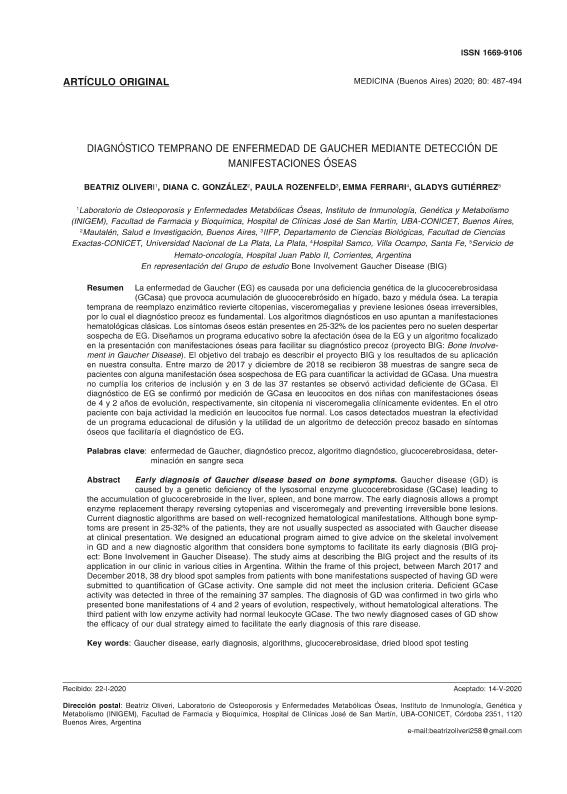Mostrar el registro sencillo del ítem
dc.contributor.author
Oliveri, María Beatriz

dc.contributor.author
González, Diana
dc.contributor.author
Rozenfeld, Paula Adriana

dc.contributor.author
Ferrari, Emma
dc.contributor.author
Gutierrez, Gladys
dc.date.available
2022-04-07T19:37:30Z
dc.date.issued
2020-10
dc.identifier.citation
Oliveri, María Beatriz; González, Diana; Rozenfeld, Paula Adriana; Ferrari, Emma; Gutierrez, Gladys; Diagnóstico temprano de enfermedad de Gaucher mediante detección de manifestaciones óseas; Medicina (Buenos Aires); Medicina (Buenos Aires); 80; 5; 10-2020; 487-494
dc.identifier.issn
0025-7680
dc.identifier.uri
http://hdl.handle.net/11336/154659
dc.description.abstract
La enfermedad de Gaucher (EG) es causada por una deficiencia genética de la glucocerebrosidasa (GCasa) que provoca acumulación de glucocerebrósido en hígado, bazo y médula ósea. La terapia temprana de reemplazo enzimático revierte citopenias, visceromegalias y previene lesiones óseas irreversibles, por lo cual el diagnóstico precoz es fundamental. Los algoritmos diagnósticos en uso apuntan a manifestaciones hematológicas clásicas. Los síntomas óseos están presentes en 25-32% de los pacientes pero no suelen despertar sospecha de EG. Diseñamos un programa educativo sobre la afectación ósea de la EG y un algoritmo focalizado en la presentación con manifestaciones óseas para facilitar su diagnóstico precoz (proyecto BIG: Bone Involvement in Gaucher Disease). El objetivo del trabajo es describir el proyecto BIG y los resultados de su aplicación en nuestra consulta. Entre marzo de 2017 y diciembre de 2018 se recibieron 38 muestras de sangre seca de pacientes con alguna manifestación ósea sospechosa de EG para cuantificar la actividad de GCasa. Una muestra no cumplía los criterios de inclusión y en 3 de las 37 restantes se observó actividad deficiente de GCasa. El diagnóstico de EG se confirmó por medición de GCasa en leucocitos en dos niñas con manifestaciones óseas de 4 y 2 años de evolución, respectivamente, sin citopenia ni visceromegalia clínicamente evidentes. En el otro paciente con baja actividad la medición en leucocitos fue normal. Los casos detectados muestran la efectividad de un programa educacional de difusión y la utilidad de un algoritmo de detección precoz basado en síntomas óseos que facilitaría el diagnóstico de EG.
dc.description.abstract
Gaucher disease (GD) is caused by a genetic deficiency of the lysosomal enzyme glucocerebrosidase (GCase) leading to the accumulation of glucocerebroside in the liver, spleen, and bone marrow. The early diagnosis allows a prompt enzyme replacement therapy reversing cytopenias and visceromegaly and preventing irreversible bone lesions. Current diagnostic algorithms are based on well-recognized hematological manifestations. Although bone symptoms are present in 25-32% of the patients, they are not usually suspected as associated with Gaucher disease at clinical presentation. We designed an educational program aimed to give advice on the skeletal involvement in GD and a new diagnostic algorithm that considers bone symptoms to facilitate its early diagnosis (BIG project: Bone Involvement in Gaucher Disease). The study aims at describing the BIG project and the results of its application in our clinic in various cities in Argentina. Within the frame of this project, between March 2017 and December 2018, 38 dry blood spot samples from patients with bone manifestations suspected of having GD were submitted to quantification of GCase activity. One sample did not meet the inclusion criteria. Deficient GCase activity was detected in three of the remaining 37 samples. The diagnosis of GD was confirmed in two girls who presented bone manifestations of 4 and 2 years of evolution, respectively, without hematological alterations. The third patient with low enzyme activity had normal leukocyte GCase. The two newly diagnosed cases of GD show the efficacy of our dual strategy aimed to facilitate the early diagnosis of this rare disease.
dc.format
application/pdf
dc.language.iso
spa
dc.publisher
Medicina (Buenos Aires)

dc.rights
info:eu-repo/semantics/openAccess
dc.rights.uri
https://creativecommons.org/licenses/by-nc-sa/2.5/ar/
dc.subject
Enfermedad de Gaucher
dc.subject
Diagnóstico Precoz
dc.subject
Algoritmo Diagnóstico
dc.subject
Glucocerebrosidasa
dc.subject
Determinación en Sangre Seca
dc.subject.classification
Genética Humana

dc.subject.classification
Medicina Básica

dc.subject.classification
CIENCIAS MÉDICAS Y DE LA SALUD

dc.title
Diagnóstico temprano de enfermedad de Gaucher mediante detección de manifestaciones óseas
dc.title
Early diagnosis of Gaucher disease based on bone symptoms
dc.type
info:eu-repo/semantics/article
dc.type
info:ar-repo/semantics/artículo
dc.type
info:eu-repo/semantics/publishedVersion
dc.date.updated
2021-09-06T17:46:40Z
dc.identifier.eissn
1669-9106
dc.journal.volume
80
dc.journal.number
5
dc.journal.pagination
487-494
dc.journal.pais
Argentina

dc.journal.ciudad
Buenos Aires
dc.description.fil
Fil: Oliveri, María Beatriz. Consejo Nacional de Investigaciones Científicas y Técnicas. Oficina de Coordinación Administrativa Houssay. Instituto de Inmunología, Genética y Metabolismo. Universidad de Buenos Aires. Facultad de Medicina. Instituto de Inmunología, Genética y Metabolismo; Argentina
dc.description.fil
Fil: González, Diana. Mautalén, Salud e Investigación; Argentina
dc.description.fil
Fil: Rozenfeld, Paula Adriana. Consejo Nacional de Investigaciones Científicas y Técnicas. Centro Científico Tecnológico Conicet - La Plata. Instituto de Estudios Inmunológicos y Fisiopatológicos. Universidad Nacional de La Plata. Facultad de Ciencias Exactas. Instituto de Estudios Inmunológicos y Fisiopatológicos; Argentina
dc.description.fil
Fil: Ferrari, Emma. Hospital Samco; Argentina
dc.description.fil
Fil: Gutierrez, Gladys. Hospital Juan Pablo II. Servicio de Hemato-oncología; Argentina
dc.journal.title
Medicina (Buenos Aires)

dc.relation.alternativeid
info:eu-repo/semantics/altIdentifier/url/https://www.medicinabuenosaires.com/indices-de-2020/volumen-80-ano-2020-no-5-indice/diagnostico_temprano/#:~:text=Diagn%C3%B3stico%20temprano%20de%20enfermedad%20de%20Gaucher%20mediante%20detecci%C3%B3n%20de%20manifestaciones%20%C3%B3seas,-MEDICINA%20BUENOS%20AIRES&text=Resumen%20La%20enfermedad%20de%20Gaucher,h%C3%ADgado%2C%20bazo%20y%20m%C3%A9dula%20%C3%B3sea.
Archivos asociados
